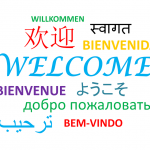
By Rachel Collishaw
So this post (originally on the author’s site) was prompted by the awesome #sschat on Monday, May 8th, 2017 on Ending the Year with a Bang! And it brought up this activity that I did with my world history class (CHW3M – World to 1500 CE) a few years ago. Lots of teachers asked me for pictures of the activity, but, for some crazy reason, I didn’t take any! So, as promised, here’s a description of the activity and some of the insights that my students had because of the activity.
What I love about this activity is that it can be adapted to any topic in history, students use their numeracy skills and must apply the historical significance criteria and really think big-picture about continuity and change. (editor’s note: Rachel’s “Numeracy and Historical Thinking” post will be published here soon for more details about this).
Materials Needed
I started with a roll of newsprint end – one of the tech teachers was going to the Ottawa Citizen office to pick some up, and asked if I wanted any. I didn’t yet know what I would use it for, but timelines seemed like a likely candidate, and it was free! Of course, you can use any long paper that you have handy, but for this activity, it needed to be LONG! Big metre sticks and lots of markers also a necessity!
Ending with a Bang!
It was a few days before the end of the semester, and my students were getting ready for their year-end interviews and I wanted them to be able to put the whole course in context and see some of the changes and continuities over this huge swath of history. I also wanted to have an interactive and engaging activity.
Divide and Conquer!
I unrolled a long swath of the newsprint in the hallway (about 20-30 m) and asked for volunteers to set up the “marker dates.” Two volunteers stepped up and started figuring out what the scale would need to be to show the invention of beer (their choice!) in 5000 BCE and to still show some of the complexities of several societies in the 15th century CE.
The rest of the class divided into small groups and was assigned one civilization that we had studied (this worked out to groups of 2 or 3). They had to review their notes and the textbook and establish 4-10 significant people, events or developments (PEDs) in that civilization. They had to include:
- a beginning PED
- a rising PED
- a flourishing PED
- a declining PED
- a legacy PED
The research/review and timeline set-up phase took about 1 class period. In the next class period, the students put their people, events, developments on the actual timeline using their designated marker colour (we had to repeat some for sure).
Observe, Question, Reflect
This is where I wish I still had the students’ journals to look at – so many questions, observations and reflections arose! Here are some of the questions, observations and reflections that I do recall:
- Wow! the beginning of agriculture was a LONG time before most of the civilizations we studied (like a REALLY long time!)
- Why is there so much more activity in the 15th century?
- Is there actually more activity in the 15th century, or do we just have more records remaining?
- Does it have something to do with the printing press?
- Exploration and trade?
- European revival and therefore more records in English?
- The Mongols were so short-lived, but they appear on EVERYONE else’s timeline!
- We spend so much time thinking about civilization x, but civilization y lasted so much longer – why is that?
- It really makes you think about how long our own civilization might last
- 1500 seems so long ago, but there was SO much more history before it than since
- Some things appear as achievements on one timeline, but mistakes on another – I guess it’s all relative
Bonus:
As other students, teachers and administrators walked through the halls, they could see us building our timeline, and they often stopped to ask my students what the heck was going on. It was a great opportunity to promote the course, and show what historical thinking is all about!
Rachel Collishaw is a cross-cultural literacy instructional coach, secondary, in Ottawa-Carleton District School Board. She is a VP of OHASSTA.


